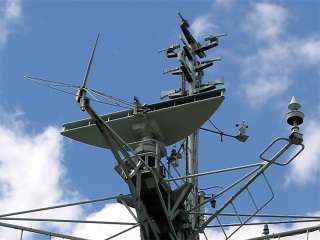Type 293
Description of the radar set, tactical-technical characteristics

Figure 1: Type 293
© 2004 Jörg Waterstraat, (www.kriegsschiffe.eu)

| Specifications | |
|---|---|
| frequency: | S-Band |
| pulse repetition time (PRT): | |
| pulse repetition frequency (PRF): | 500 Hz |
| pulsewidth (τ): | 0.7 and 1.9 µs |
| receive time: | |
| dead time: | |
| peak power: | 500 kW |
| average power: | |
| instrumented range: | 25 NM (≙ 46 km) |
| range resolution: | 110 or 300 m |
| accuracy: | |
| beamwidth: | 2° |
| hits per scan: | |
| antenna rotation: | 5, 10 or 15 min-1 |
| MTBCF: | |
| MTTR: | |
Type 293
The Type 293 is an operating in S-Band surveillance and target designation radar. The radar is equipped with a so-called “cheese antenna” forming a fan-beam antenna pattern. It acquired that name because it looked like a block of cheese cut in half.
The Type 293 radar system first saw service in 1944 with a 6 foot antenna (6 ft × 4 in ≙ 4° × 35°). The rotation rate was 15 rpm and the pulse length 1.5 µs at a PRF of 500 Hz. Type 293M, which incorporated an 8 foot antenna (8 ft × 7.5 in ≙ 3° × 30°). It was introduced into service in 1945 and provided a maximum range of 15 NM (≙ 28 km). Type 293P was similar to the previous model but it was modified for easier maintenance. A post-war radar program introduced in early 1960s the Type 293Q set with a redesigned 12 foot antenna (12 ft × 7.5 in ≙ 2° × 30°).[1] In the Swedish Royal Navy this radar got the designator P-234.
Sources and ressorces:
- F.A. Kingsley: ''The Applications of Radar and Other Electronic Systems in the Royal Navy in World War 2'' Springer, 2016, ISBN 9781349136230 p. 26 (online preview)
